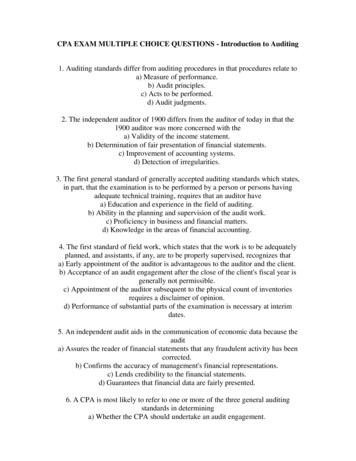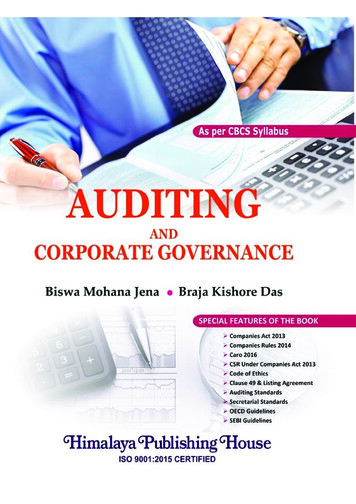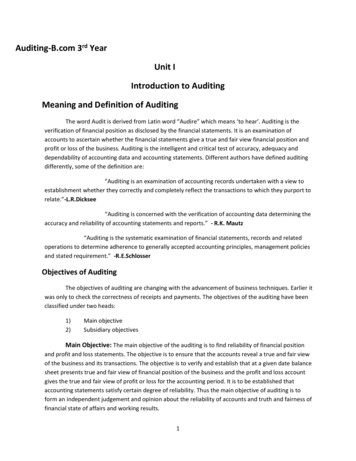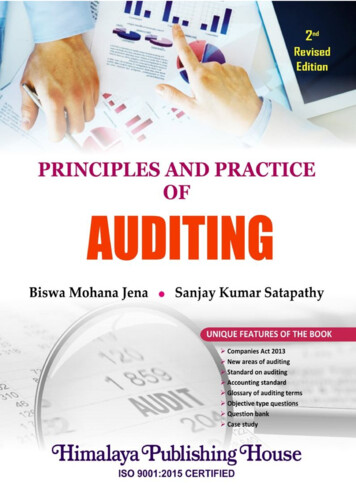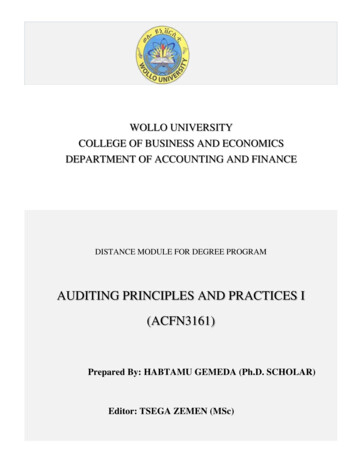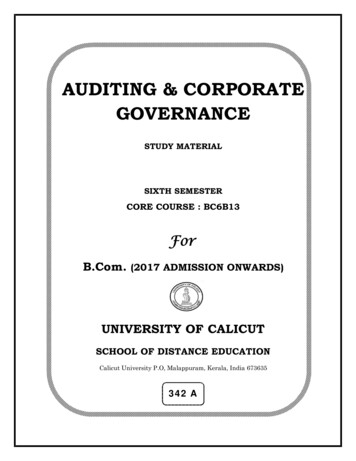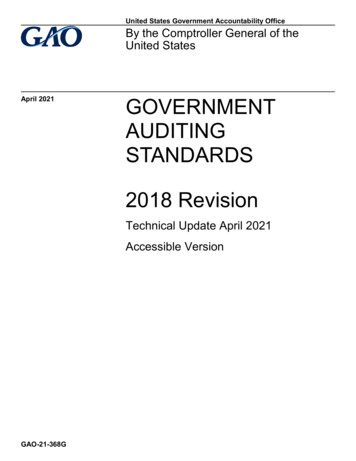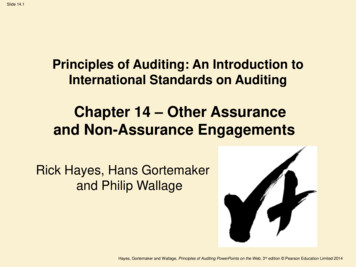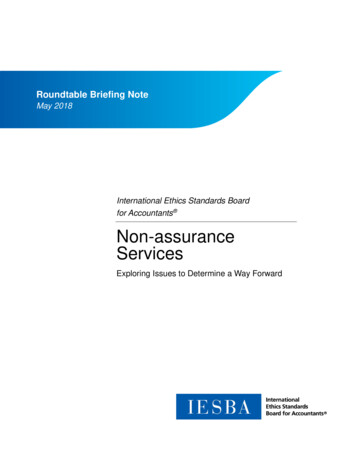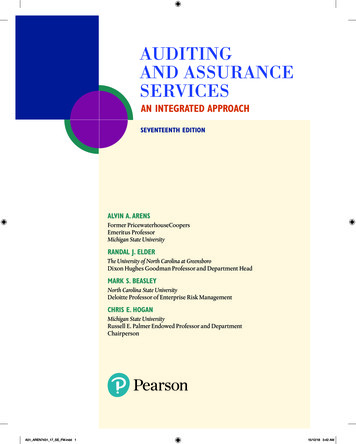
Transcription
AUDITINGAND ASSURANCESERVICESAN INTEGRATED APPROACHSEVENTEENTH EDITIONALVIN A. ARENSFormer PricewaterhouseCoopersEmeritus ProfessorMichigan State UniversityRANDAL J. ELDERThe University of North Carolina at GreensboroDixon Hughes Goodman Professor and Department HeadMARK S. BEASLEYNorth Carolina State UniversityDeloitte Professor of Enterprise Risk ManagementCHRIS E. HOGANMichigan State UniversityRussell E. Palmer Endowed Professor and DepartmentChairpersonA01 AREN7431 17 SE FM.indd 115/12/18 3:42 AM
Vice President, Business, Economics, and UKCourseware: Donna BattistaDirector of Portfolio Management: Adrienne D’AmbrosioSenior Portfolio Manager: Ellen GearyVice President, Product Marketing: Roxanne McCarleySenior Product Marketer: Becky BrownProduct Marketing Assistant: Marianela SilvestriManager of Field Marketing, Business Publishing:Adam GoldsteinField Marketing Manager: Nayke PopovichVice President, Production and Digital Studio, Arts andBusiness: Etain O’DeaDirector, Production and Digital Studio, Business andEconomics: Ashley SantoraManaging Producer, Business: Melissa FeimerSenior Content Producer: Gladys SotoOperations Specialist: Carol MelvilleDesign Lead: Kathryn FootManager, Learning Tools: Brian SuretteLearning Tools Strategist: Michael TrinchettoManaging Producer, Digital Studio and GLP:James BatemanManaging Producer, Digital Studio: Diane LombardoDigital Studio Producer: Mary Kate MurrayDigital Studio Producer: Alana ColesDigital Content Team Lead: Noel LotzDigital Content Project Lead: Martha LaChanceFull Service Project Management: Jennifer Gavigan,Integra Software Services, Inc.Interior Design: Integra Software Services, Inc.Cover Design: Integra Software Services, Inc.Cover Art: Integra Software Services, Inc.Printer/Binder: LSC Communications, Inc.Cover Printer: Phoenix Color/HagerstownMicrosoft and/or its respective suppliers make no representations about the suitability of the information contained in the documentsand related graphics published as part of the services for any purpose. All such documents and related graphics are provided “as is”without warranty of any kind. Microsoft and/or its respective suppliers hereby disclaim all warranties and conditions with regard tothis information, including all warranties and conditions of merchantability, whether express, implied or statutory, fitness for a particular purpose, title and non-infringement. In no event shall Microsoft and/or its respective s uppliers be liable for any special, indirector consequential damages or any damages whatsoever resulting from loss of use, data or profits, whether in an action of contract, negligence or other tortious action, arising out of or in connection with the use or performance of information available from the services.The documents and related graphics contained herein could include technical inaccuracies or typographical errors. Changes are periodically added to the information herein. Microsoft and/or its respective s uppliers may make improvements and/or changes in theproduct(s) and/or the program(s) described herein at any time. Partial screen shots may be viewed in full within the software versionspecified.Microsoft and Windows are registered trademarks of the Microsoft Corporation in the U.S.A. and other countries. This book isnot sponsored or endorsed by or affiliated with the Microsoft Corporation.Copyright 2020, 2017, 2014 by Pearson Education, Inc. or its affiliates. All Rights Reserved. Manufactured in the United Statesof America. This publication is protected by copyright, and p ermission should be obtained from the publisher prior to anyprohibited reproduction, storage in a retrieval system, or transmission in any form or by any means, electronic, mechanical, photocopying, recording, or otherwise. For information regarding permissions, request forms, and the appropriate contactswithin the Pearson Education Global Rights and Permissions department, please s of third-party content appear on the appropriate page within the text -OR- on page 896, which constitutesan extension of this copyright page.PEARSON, ALWAYS LEARNING, and MYLAB are exclusive trademarks owned by Pearson Education, Inc. or its affiliates in theU.S. and/or other countries.Unless otherwise indicated herein, any third-party trademarks, logos, or icons that may appear in this work are the property oftheir respective owners, and any references to third-party t rademarks, logos, icons, or other trade dress are for demonstrative ordescriptive purposes only. Such references are not intended to imply any sponsorship, endorsement, authorization, or promotion of Pearson’s products by the owners of such marks, or any relationship between the owner and Pearson Education, Inc., orits affiliates, authors, licensees, or distributors.Library of Congress Cataloging-in-Publication DataNames: Arens, Alvin A.; Elder, Randal J.; Beasley, Mark S.; Hogan, Chris E., authors.Title: Auditing and assurance services / by Alvin A. Arens, Randal J. Elder,Mark S. Beasley, Chris E. Hogan.Description: 17e [edition]. Upper Saddle River, NJ : Pearson, [2020] Includes index.Identifiers: LCCN 2018035103 ISBN 9780134897431 (softcover)Subjects: LCSH: Auditing.Classification: LCC HF5667 .A69 2020 DDC 657/.45–dc23LC record available at https://lccn.loc.gov/2018035103ISBN 10: 0-13-489743-9ISBN 13: 978-0-13-489743-1A01 AREN7431 17 SE FM.indd 215/12/18 3:42 AM
CONTINUINGTHE LEGACY OFALVIN A. ARENSALVIN A. ARENS: The author team of Randy Elder,Mark Beasley, and Chris Hogan, are pleased to continuethe outstanding legacy of our book’s founding author,Al Arens, in this 17th edition of Auditing and AssuranceServices: An Integrated Approach. As was done for the 15thand 16th editions, we again dedicate this new edition toAl’s memory.Randy and Mark joined Al as coauthors on this textbookin the 8th edition, and have been honored to continueAl’s leadership in helping shape classroom instructionand student learning about auditing concepts and theirpractical implementation around the world. Since thefirst edition was published, this textbook has impactedaudit education for nearly 40 years in the U.S. and globNovember 24, 1935 – December 6, 2010ally, including seven different language translations. Al’sleadership at national and international levels and hiscommitment to expanding knowledge through the development of educational materials, including this textbook, continue to inspire us as we strive to advance his legacyfor future generations of auditing professionals.Al was the PricewaterhouseCoopers Auditing Professor and member of the Accounting & Information Systems faculty in the Eli Broad College of Business at MichiganState University from 1968 through 2007. Thus, we are especially pleased that ChrisHogan, Professor at Michigan State University, joined the author team in the 16th edition, continuing the Michigan State connection started by Al.Among his many honors, Al was selected as one of five national auditing educatorsto hold a Price Waterhouse Auditing professorship, was honored as AICPA Educatorof the Year, served on the AICPA Auditing Standards Board, and was President of theAmerican Accounting Association. Al taught accounting, mainly auditing, with a passion that is legendary. He had a heart for sharing his knowledge of auditing with students throughout his career.This 17th edition continues his outstanding legacy in audit education.iiiA01 AREN7431 17 SE FM.indd 315/12/18 3:42 AM
ABOUT THEAUTHORSALVIN A. ARENSAl Arens, founding author of this textbook, was the PricewaterhouseCoopersProfessor of Accounting Emeritus at Michigan State University. In addition to writingbooks on auditing, he was a coauthor of computerized accounting supplements andhe was actively involved in the continuing education of practitioners with local andregional CPA firms. Al was a past president of the American Accounting Associationand a former member of the AICPA Auditing Standards Board. He practiced publicaccounting with both a local CPA firm and the predecessor firm to Ernst & Young.He received many awards including the AAA Auditing Section Outstanding Educatoraward, the AICPA Outstanding Educator award, the national Beta Alpha Psi Professorof the Year award, and many teaching and other awards at Michigan State.RANDAL J. ELDERRandy Elder, who has served as a coauthor of this textbook since the 8th edition, is Dixon Hughes Goodman Professor and Department Head of Accounting andFinance at the University of North Carolina at Greensboro. He teaches undergraduateand graduate auditing courses, and has received several teaching awards. His researchfocuses on audit quality and current audit firm practices and he served as the teamleader for the American Accounting Association Auditing Section PCAOB researchsynthesis teams on audit confirmations and audit sampling. He has extensive publicaccounting experience with a large regional CPA firm, frequently teaches continuingeducation for a large international CPA firm, and is a member of the AICPA.MARK S. BEASLEYMark Beasley, who has also served as a coauthor of this textbook since the 8thedition, is the Deloitte Professor of Enterprise Risk Management and Professorof Accounting at North Carolina State University. He has taught undergraduateand graduate auditing courses, and has received several teaching awards including membership in NC State’s Academy of Outstanding Teachers. He has extensiveprofessional audit experience with the predecessor firm to Ernst & Young and has extensive standards-setting experience working with the Auditing Standards Board asa Technical Manager in the Audit and Assurance Division of the AICPA. He servedon the ASB Fraud Standard Task Force responsible for developing SAS 99, the ASBAntifraud Programs and Controls Task Force, and the Advisory Council overseeingthe COSO Enterprise Risk Management—Integrated Framework project. He servedover seven years as a member of the COSO Board, representing the AAA.CHRIS E. HOGANWe are pleased that Chris Hogan joined us as a coauthor starting with the 16th edition. Chris is the Russell E. Palmer Endowed Professor of Accounting and DepartmentChairperson in the Eli Broad College of Business at Michigan State University. We arethrilled to continue the Michigan State connection started by Al Arens. Chris teachesgraduate auditing and her research focuses on internal controls and integrated audits, audit firm client portfolios, and the impact of regulation on audit markets.Chris has auditing experience with Price Waterhouse, one of the predecessor firmsto PricewaterhouseCoopers, LLP. She has served in multiple leadership roles withinthe American Accounting Association, including serving as President of the AuditingSection and on the Audit Committee of the AAA.ivA01 AREN7431 17 SE FM.indd 415/12/18 3:42 AM
CONTENTSPREFACE XVIITHE AUDITING PROFESSIONTHE DEMAND FOR AUDITAND OTHER ASSURANCE SERVICESLEARNING OBJECTIVES 3Nature of Auditing 4Distinction Between Auditing and Accounting 6Economic Demand for Auditing 6Assurance Services 8Types of Audits 12Types of Auditors 14Certified Public Accountant 16Summary 17Essential Terms 17Review Questions 18Multiple Choice Questions From CPA Examinations 18Multiple Choice Questions From Becker CPA Exam Review* 19Discussion Questions and Problems 20THE CPA PROFESSIONLEARNING OBJECTIVES 24Certified Public Accounting Firms 25Structure of CPA Firms 27Sarbanes–Oxley Act and Public Company Accounting Oversight Board 29Securities and Exchange Commission 30American Institute of Certified Public Accountants (AICPA) 31International and U.S. Auditing Standards 32Organization of U.S. Auditing Standards 34Quality Control 38Summary 40Essential Terms 41Review Questions 42*PART1CHAPTER1CHAPTER2Multiple Choice Questions Becker Professional Education.vA01 AREN7431 17 SE FM.indd 515/12/18 3:42 AM
Multiple Choice Questions From CPA Examinations 42Multiple Choice Questions From Becker CPA Exam Review* 43Discussion Questions and Problems 44CHAPTER3CHAPTER4CHAPTER5viAUDIT REPORTSLEARNING OBJECTIVES 47Standard Unmodified Opinion Audit Report for Nonpublic Entities 48Conditions for Standard Unmodified Opinion Audit Report 51Standard Audit Report and Report on Internal Control Over FinancialReporting Under PCAOB Auditing Standards 52Unmodified Opinion Audit Report With Emphasis-of-Matter ExplanatoryParagraph or Nonstandard Report Wording 58Modifications to the Opinion in the Audit Report 62Materiality 63Discussion of Conditions Requiring a Modification of Opinion 67Auditor’s Decision Process for Audit Reports 71International Accounting and Auditing Standards 73Summary 73Essential Terms 74Review Questions 74Multiple Choice Questions From CPA Examinations 75Multiple Choice Questions From Becker CPA Exam Review* 76Discussion Questions and Problems 77PROFESSIONAL ETHICSLEARNING OBJECTIVES 82What Are Ethics? 83Ethical Dilemmas 84Special Need for Ethical Conduct in Professions 87Code of Professional Conduct 89Independence Rule 94Sarbanes–Oxley and Related Independence Requirements 98Other Rules of Conduct 101Enforcement 108Summary 110Essential Terms 111Review Questions 111Multiple Choice Questions From CPA Examinations 112Multiple Choice Questions From Becker CPA Review* 113Discussion Questions and Problems 113Cases 117LEGAL LIABILITYLEARNING OBJECTIVES 119Legal Environment for CPAs 120Distinguishing Business Failure, Audit Failure, and Audit Risk 121Legal Concepts Affecting Liability 122CONTENTSA01 AREN7431 17 SE FM.indd 615/12/18 3:42 AM
Liability to Clients 124Liability to Third Parties Under Common Law 127Civil Liability Under the Federal Securities Laws 129Criminal Liability 135The Profession’s Response to Legal Liability 136Summary 137Essential Terms 138Review Questions 139Multiple Choice Questions From CPA Examinations 139Multiple Choice Questions From Becker CPA Exam Review* 140Discussion Questions and Problems 141Case 146THE AUDIT PROCESSAUDIT RESPONSIBILITIES AND OBJECTIVESLEARNING OBJECTIVES 148Objective of Conducting an Audit of Financial Statements 149Management’s Responsibilities 150Auditor’s Responsibilities 151Professional Skepticism 155Professional Judgment 156Financial Statement Cycles 159Setting Audit Objectives 163Management Assertions 164Transaction-Related Audit Objectives 167Balance-Related Audit Objectives 169How Audit Objectives Are Met 172Summary 175Essential Terms 175Review Questions 176Multiple Choice Questions From CPA Examinations 177Multiple Choice Questions From Becker CPA Exam Review* 178Discussion Questions and Problems 179AUDIT EVIDENCELEARNING OBJECTIVES 185Nature of Evidence 186Audit Evidence Decisions 187Persuasiveness of Evidence 188Types of Audit Evidence 191Analytical Procedures 199Use of Data Analytics and Other Advanced Technologies 202Common Financial Ratios 206Audit Documentation 209Contents and Organization 210Summary 216PART26CHAPTERCHAPTER7CONTENTSA01 AREN7431 17 SE FM.indd 7vii15/12/18 3:42 AM
Essential Terms 216Review Questions 218Multiple Choice Questions From CPA Examinations 219Multiple Choice Questions From Becker CPA Exam Review* 220Discussion Questions and Problems 221CHAPTER8CHAPTER9viiiAUDIT PLANNING AND MATERIALITYLEARNING OBJECTIVES 229Planning 230Accept Client and Perform Initial Audit Planning 231Understand the Client’s Business and Industry 236Perform Preliminary Analytical Procedures 241Materiality 244Materiality for Financial Statements as a Whole 245Determine Performance Materiality 248Estimate Misstatement and Compare With Preliminary Judgment 250Summary 252Essential Terms 254Review Questions 255Multiple Choice Questions From CPA Examinations 256Multiple Choice Questions From Becker CPA Exam Review* 257Discussion Questions and Problems 258Case 266Integrated Case Application —Pinnacle Manufacturing: Part I 267ASSESSING THE RISK OF MATERIALMISSTATEMENTLEARNING OBJECTIVES 270Audit Risk 271Risk Assessment Procedures 272Considering Fraud Risk 276Identification of Significant Risks 277Audit Risk Model 278Assessing Acceptable Audit Risk 282Assessing Inherent Risk 285Relationship of Risks to Evidence and Factors Influencing Risks 288Relationship of Risk and Materiality to Audit Evidence 292Summary 293Essential Terms 294Review Questions 294Multiple Choice Questions From CPA Examinations 295Multiple Choice Questions From Becker CPA Exam Review* 297Discussion Questions and Problems 297Case 302Integrated Case Application—Pinnacle Manufacturing: Part II 302CONTENTSA01 AREN7431 17 SE FM.indd 815/12/18 3:42 AM
ASSESSING AND RESPONDINGTO FRAUD RISKSLEARNING OBJECTIVES 304Types of Fraud 305Conditions for Fraud 306Assessing the Risk of Fraud 310Corporate Governance Oversight to Reduce Fraud Risks 314Responding to the Risk of Fraud 318Specific Fraud Risk Areas 321Responsibilities When Fraud is Suspected 326Documenting the Fraud Assessment 330Summary 331Essential Terms 331Review Questions 332Multiple Choice Questions From CPA Examinations 333Multiple Choice Questions From Becker CPA Exam Review* 334Discussion Questions and Problems 335Integrated Case Application—Pinnacle Manufacturing: Part III 341INTERNAL CONTROL AND COSOFRAMEWORKLEARNING OBJECTIVES 342Internal Control Objectives 343Management and Auditor Responsibilities for Internal Control 344COSO Components of Internal Control 347Internal Controls Specific to Information Technology 356Impact of IT Infrastructure on Internal Control 363Summary 365Essential Terms 365Review Questions 367Multiple Choice Questions From CPA Examinations 368Multiple Choice Questions From Becker CPA Exam Review* 369Discussion Questions and Problems 369Case 373ASSESSING CONTROL RISK AND REPORTINGON INTERNAL CONTROLSLEARNING OBJECTIVES 375Obtain and Document Understanding of Internal Control 376Assess Control Risk 379Tests of Controls 384Decide Planned Detection Risk and Design Substantive Tests 390Auditor Reporting On Internal Control 390CHAPTER10CHAPTER11CHAPTER12CONTENTSA01 AREN7431 17 SE FM.indd 9ix15/12/18 3:42 AM
Evaluating, Reporting, and Testing Internal Control for Nonpublic andSmaller Public Companies 393Impact of IT Environment on Control Risk Assessment and Testing 395Summary 399Essential Terms 399Review Questions 401Multiple Choice Questions From CPA Examinations 402Multiple Choice Questions From Becker CPA Exam Review* 403Discussion Questions and Problems 404Case 412Integrated Case Application—Pinnacle Manufacturing: Part IV 413CHAPTER13PART3CHAPTER14OVERALL AUDIT STRATEGYAND AUDIT PROGRAMLEARNING OBJECTIVES 416Types of Tests 417Selecting Which Types of Tests to Perform 423Evidence Mix 426Design of the Audit Program 428Summary of Key Evidence-Related Terms 437Summary of the Audit Process 438Summary 442Essential Terms 442Review Questions 443Multiple Choice Questions From CPA Examinations 444Multiple Choice Questions From Becker CPA Exam Review* 445Discussion Questions and Problems 446Cases 451APPLICATION OF THE AUDIT PROCESS TOTHE SALES AND COLLECTION CYCLEAUDIT OF THE SALES AND COLLECTIONCYCLE: TESTS OF CONTROLS ANDSUBSTANTIVE TESTS OF TRANSACTIONSLEARNING OBJECTIVES 455Accounts and Classes of Transactions in the Sales and Collection Cycle 456Business Functions in the Cycle and Related Documents and Records 457Methodology for Designing Tests of Controls and Substantive Tests ofTransactions for Sales 462Sales Returns and Allowances 474Methodology for Designing Tests of Controls and Substantive Tests ofTransactions for Cash Receipts 474Audit Tests for Uncollectible Accounts 478xCONTENTSA01 AREN7431 17 SE FM.indd 1015/12/18 3:42 AM
Effect of Results of Tests of Controls and Substantive Tests ofTransactions 479Summary 480Essential Terms 481Review Questions 481Multiple Choice Questions From CPA Examinations 482Multiple Choice Questions From Becker CPA Exam Review* 484Discussion Questions and Problems 484Case 491Integrated Case Application—Pinnacle Manufacturing: Part V 492AUDIT SAMPLING FOR TESTS OF CONTROLSAND SUBSTANTIVE TESTS OF TRANSACTIONSLEARNING OBJECTIVES 493Representative Samples 494Statistical Versus Nonstatistical Sampling and Probabilistic VersusNonprobabilistic Sample Selection 495Sample Selection Methods 496Sampling for Exception Rates 499Application of Nonstatistical Audit Sampling 500Statistical Audit Sampling 516Application of Statistical Attributes Sampling 518Summary 523Essential Terms 523Review Questions 524Multiple Choice Questions From CPA Examinations 525Multiple Choice Questions From Becker CPA Exam Review* 527Discussion Questions and Problems 527Case 533Integrated Case Application—Pinnacle Manufacturing: Part VI 533COMPLETING THE TESTS IN THE SALES ANDCOLLECTION CYCLE: ACCOUNTS RECEIVABLELEARNING OBJECTIVES 535Methodology for Designing Tests of Details of Balances 536Designing Tests of Details of Balances 542Confirmation of Accounts Receivable 549Developing Tests of Details Audit Program 555Summary 558Essential Terms 558Review Questions 559Multiple Choice Questions From CPA Examinations 560Multiple Choice Questions From Becker CPA Exam Review* 562Discussion Questions and Problems 562Case 569Integrated Case Application—Pinnacle Manufacturing: Part VII 570CHAPTER15CHAPTER16CONTENTSA01 AREN7431 17 SE FM.indd 11xi15/12/18 3:42 AM
CHAPTER17AUDIT SAMPLING FOR TESTSOF DETAILS OF BALANCESLEARNING OBJECTIVES 575Comparisons of Audit Sampling for Tests of Details of Balances and for Testsof Controls and Substantive Tests of Transactions 576Nonstatistical Sampling 577Monetary Unit Sampling 586Variables Sampling 595Illustration Using Difference Estimation 600Summary 603Essential Terms 604Review Questions 604Multiple Choice Questions From CPA and CIA Examinations 606Multiple Choice Questions From Becker CPA Exam Review* 607Discussion Questions and Problems 608Cases 613PARTAPPLICATION OF THE AUDIT PROCESSTO OTHER CYCLESCHAPTERAUDIT OF THE ACQUISITION ANDPAYMENT CYCLE: TESTS OF CONTROLS,SUBSTANTIVE TESTS OF TRANSACTIONS,AND ACCOUNTS PAYABLE418LEARNING OBJECTIVES 616Accounts and Classes of Transactions in the Acquisition and PaymentCycle 617Business Functions in the Cycle and Related Documents and Records 618Methodology for Designing Tests of Controls and Substantive Tests ofTransactions 621Methodology for Designing Tests of Details of Balances for AccountsPayable 628Summary 637Essential Terms 637Review Questions 638Multiple Choice Questions From CPA Examinations 639Multiple Choice Questions From Becker CPA Exam Review* 640Discussion Questions and Problems 640Case 647xiiCONTENTSA01 AREN7431 17 SE FM.indd 1215/12/18 3:42 AM
COMPLETING THE TESTS IN THEACQUISITION AND PAYMENT CYCLE:VERIFICATION OF SELECTED ACCOUNTSCHAPTER19LEARNING OBJECTIVES 649Types of Other Accounts in the Acquisition and Payment Cycle 650Audit of Property, Plant, and Equipment 650Audit of Prepaid Expenses 658Audit of Accrued Liabilities 661Audit of Income and Expense Accounts 663Summary 666Essential Terms 667Review Questions 667Multiple Choice Questions From CPA Examinations 668Multiple Choice Questions From Becker CPA Exam Review* 669Discussion Questions and Problems 670Cases 673AUDIT OF THE PAYROLL ANDPERSONNEL CYCLELEARNING OBJECTIVES 676Accounts and Transactions in the Payroll and Personnel Cycle 677Business Functions in the Cycle and Related Documents and Records 677Methodology for Designing Tests of Controls and Substantive Tests ofTransactions 680Methodology for Designing Substantive Analytical Procedures and Testsof Details of Balances 686Summary 690Essential Terms 690Review Questions 691Multiple Choice Questions From CPA Examinations 692Multiple Choice Questions From Becker CPA Exam Review* 693Discussion Questions and Problems 693Case 697AUDIT OF THE INVENTORY ANDWAREHOUSING CYCLELEARNING OBJECTIVES 699Business Functions in the Cycle and Related Documents and Records 700Parts of the Audit of Inventory 702Audit of Cost Accounting 705Substantive Analytical Procedures 708Physical Observation of Inventory 709Audit of Pricing and Compilation 713Integration of the Tests 716CHAPTER20CHAPTER21CONTENTSA01 AREN7431 17 SE FM.indd 13xiii15/12/18 3:42 AM
Summary 718Essential Terms 718Review Questions 719Multiple Choice Questions From CPA Examinations 720Multiple Choice Questions From Becker CPA Exam Review* 720Discussion Questions and Problems 721Case 728CHAPTER22CHAPTER23PART5CHAPTER24xivAUDIT OF THE CAPITAL ACQUISITIONAND REPAYMENT CYCLELEARNING OBJECTIVES 730Accounts in the Cycle 731Notes Payable 732Owners’ Equity 736Summary 743Essential Terms 743Review Questions 743Multiple Choice Questions From CPA Examinations 744Multiple Choice Questions From Becker CPA Exam Review* 745Discussion Questions and Problems 746AUDIT OF CASH AND FINANCIALINSTRUMENTSLEARNING OBJECTIVES 751Types of Cash and Financial Instruments Accounts 752Cash in the Bank and Transaction Cycles 754Audit of the General Cash Account 755Fraud-Oriented Procedures 763Audit of Financial Instruments Accounts 768Summary 771Essential Terms 771Review Questions 772Multiple Choice Questions From CPA Examinations 773Multiple Choice Questions From Becker CPA Exam Review* 774Discussion Questions and Problems 774COMPLETING THE AUDITCOMPLETING THE AUDITLEARNING OBJECTIVES 781Perform Additional Tests for Presentation and Disclosure 782Review for Contingent Liabilities and Commitments 783CONTENTSA01 AREN7431 17 SE FM.indd 1415/12/18 3:42 AM
Review for Subsequent Events 788Final Evidence Accumulation 791Evaluate Results 797Issue the Audit Report 801Communicate With the Audit Committee and Management 801Subsequent Discovery of Facts 803Summary 805Essential Terms 805Review Questions 806Multiple Choice Questions From CPA Examinations 807Multiple Choice Questions From Becker CPA Exam Review* 808Discussion Questions and Problems 809Case 813OTHER ASSURANCE ANDNONASSURANCE SERVICESOTHER ASSURANCE SERVICESLEARNING OBJECTIVES 815Review, Compilation, and Preparation Services 816Review of Interim Financial Information for Public Companies 822Attestation Engagements 823Reports on Controls at Service Organizations (SOC Reports) 827Prospective Financial Statements 829Agreed-Upon Procedures Engagements 831Other Audits or Limited Assurance Engagements 831Summary 834Essential Terms 834Review Questions 835Multiple Choice Questions from CPA Examinations 836Multiple Choice Questions From Becker CPA Exam Review* 837Discussion Questions and Problems 838INTERNAL AND GOVERNMENTAL FINANCIALAUDITING AND OPERATIONAL AUDITINGLEARNING OBJECTIVES 842Internal Financial Auditing 843Governmental Financial Auditing 846Operational Auditing 849Summary 856Essential Terms 856Review Questions 857Multiple Choice Questions From CPA, CIA, and CMA Examinations 858PART6CHAPTER25CHAPTER26CONTENTSA01 AREN7431 17 SE FM.indd 15xv15/12/18 3:42 AM
Multiple Choice Questions From Becker CPA Exam Review* 859Discussion Questions and Problems 860INDEX 864CREDITS 874xviCONTENTSA01 AREN7431 17 SE FM.indd 1615/12/18 3:42 AM
PREFACEThe primary emphasis in this text is on the auditor’s decision-making process in afinancial statement audit, as well as an integrated audit of both financial statementsand internal control over financial reporting required for accelerated filer public companies. We believe that the most fundamental concepts in auditing concern determining the nature and amount of evidence the auditor should gather after considering the unique circumstances of each engagement. If students of auditing understandthe objectives to be accomplished in a given audit area,the risks related to the engagement, and the decisions to be made, they should be able to determine the appropriate evidence to gather and how to evaluate the evidence obtained.To improve student results, we recommend pairing the text content with MyLabAccounting, which is the teaching and learning platform that empowers you to reachevery student. By combining trusted author content with digital tools and a flexibleplatform, MyLab personalizes the learning experience and will help your studentslearn and retain key course concepts while developing skills that future employers areseeking in their candidates.NEW TO THIS EDITIONNew auditing standards are released without regard to textbook revision cycles. Asauditing instructors, we appreciate how critical it is to have the most current content available. This edition includes guidance in the recently issued SAS No. 133, AnAuditor Involvement with Exempt Offering Documents, and PCAOB standards, including thenew standard auditor’s report contained in AS 3101, The Auditor’s Report on an Audit ofFinancial Statements When the Auditor Expresses an Unqualified Opinion and Related Amendmentsto PCAOB Standards. In addition, we have included coverage of the AICPA’s AuditingStandards Board pending revision of the auditor’s standard unmodified opinion auditreport, so that our coverage of audit reports is up to date (as discussed further below). Itis important to note that as part of this project, the AICPA also revised the managementassertions. The changes to the assertions are reflected throughout the text.Now that the AICPA has completed its Clarity Project for auditing, attestation,and accounting and review services engagements, all chapters of the textbook reflectthe various revisions resulting from the issuance of the Clarity standards, includingcoverage up through the issuance of SSARS No. 23, Omnibus Statement on Standards forAccounting and Review Services—2016 and SSAE No. 18, Attestation Standards: Clarificationand Recodification. We are committed to continually providing you with up-to-datecontent in this dynamic global auditing environment and will keep you updated withhighlights posted on our website of major changes in new standards as they are issued.Both the AICPA’s Auditing Standards Board (ASB) and the PCAOB have recentlyrevised guidance related to auditor reporting to make the audit report more informative to users. These changes significantly changed the format and length of conten
MARK S. BEASLEY Mark Beasley, who has also served as a coauthor of this textbook since the 8th edition, is the Deloitte Professor of Enterprise Risk Management and Professor of Accounting at North Carolina State University. He has taught undergraduate and graduate auditing
